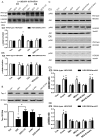Tau phosphorylation and μ-calpain activation mediate the dexamethasone-induced inhibition on the insulin-stimulated Akt phosphorylation
- PMID: 22536436
- PMCID: PMC3335002
- DOI: 10.1371/journal.pone.0035783
Tau phosphorylation and μ-calpain activation mediate the dexamethasone-induced inhibition on the insulin-stimulated Akt phosphorylation
Abstract
Evidence has suggested that insulin resistance (IR) or high levels of glucocorticoids (GCs) may be linked with the pathogenesis and/or progression of Alzheimer's disease (AD). Although studies have shown that a high level of GCs results in IR, little is known about the molecular details that link GCs and IR in the context of AD. Abnormal phosphorylation of tau and activation of μ-calpain are two key events in the pathology of AD. Importantly, these two events are also related with GCs and IR. We therefore speculate that tau phosphorylation and μ-calpain activation may mediate the GCs-induced IR. Akt phosphorylation at Ser-473 (pAkt) is commonly used as a marker for assessing IR. We employed two cell lines, wild-type HEK293 cells and HEK293 cells stably expressing the longest human tau isoform (tau-441; HEK293/tau441 cells). We examined whether DEX, a synthetic GCs, induces tau phosphorylation and μ-calpain activation. If so, we examined whether the DEX-induced tau phosphorylation and μ-calpain activation mediate the DEX-induced inhibition on the insulin-stimulated Akt phosphorylation. The results showed that DEX increased tau phosphorylation and induced tau-mediated μ-calpain activation. Furthermore, pre-treatment with LiCl prevented the effects of DEX on tau phosphorylation and μ-calpain activation. Finally, both LiCl pre-treatment and calpain inhibition prevented the DEX-induced inhibition on the insulin-stimulated Akt phosphorylation. In conclusion, our study suggests that the tau phosphorylation and μ-calpain activation mediate the DEX-induced inhibition on the insulin-stimulated Akt phosphorylation.
Conflict of interest statement
Figures





References
-
- Reaven GM. Insulin resistance: the link between obesity and cardiovascular disease. Med Clin North Am. 2011;95:875–892. - PubMed
-
- Tsoyi K, Jang HJ, Nizamutdinova IT, Park K, Kim YM, et al. PTEN differentially regulates expression of ICAM-1 and VCAM-1 through PI3K/Akt/GSK-3β/GATA-6 signaling pathways in TNF-α-activated human endothelial cells. Atherosclerosis. 2010;213:115–121. - PubMed
Publication types
MeSH terms
Substances
LinkOut - more resources
Full Text Sources
Medical
Molecular Biology Databases
Research Materials

